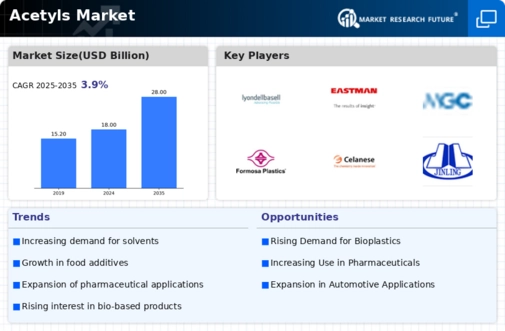Top Industry Leaders in the Acetyls Market
 Acetyls, a seemingly simple term, cloak a diverse family of organic compounds wielding immense power in shaping various industries. form the very foundation of materials like cellulose acetate used in cigarette filters, paints, and textiles. Yet, beneath this seemingly mundane label lies a dynamic competitive landscape, where established players and agile newcomers wrestle for dominance with strategies and trends as diverse as the acetyls themselves. Let's delve into the factors governing market share, recent industry news, and the exciting advancements unfolding in this multifaceted market.
Acetyls, a seemingly simple term, cloak a diverse family of organic compounds wielding immense power in shaping various industries. form the very foundation of materials like cellulose acetate used in cigarette filters, paints, and textiles. Yet, beneath this seemingly mundane label lies a dynamic competitive landscape, where established players and agile newcomers wrestle for dominance with strategies and trends as diverse as the acetyls themselves. Let's delve into the factors governing market share, recent industry news, and the exciting advancements unfolding in this multifaceted market.
Key Players and Adopted Strategies:
-
Celanese Corporation (USA): This chemical giant leverages its global reach, extensive production capacity, and brand recognition to secure a significant market share. Their focus on high-purity acetyls and technical expertise attracts premium customers in demanding industries like pharmaceuticals and aerospace. -
Eastman Chemical Company (USA): Renowned for innovation, Eastman Chemical Company capitalizes on its R&D prowess to develop novel acetyl derivatives with enhanced properties like biodegradability and fire resistance. Their focus on sustainability and niche applications resonates with environmentally conscious consumers and specialized sectors. -
Shandong Ruyi New Materials (China): This rising Chinese player leverages its domestic presence and cost-advantage to cater to the booming Asian market. Their focus on bulk production and strategic partnerships with local manufacturers strengthens their regional position. -
Mitsubishi Chemical Holdings Corporation (Japan): A diversified chemicals and materials giant, Mitsubishi Chemical leverages its vertical integration and expertise in cellulose acetate to cater to specific downstream applications like films and membranes. Their focus on closed-loop systems and resource efficiency distinguishes them in the market. -
Aceton (Spain): A leading European specialty chemicals manufacturer, Aceton focuses on niche applications like pharmaceutical-grade acetyls and customized acetyl blends. Their emphasis on stringent quality control and regulatory compliance strengthens their position in critical sectors.
Factors Shaping Market Share:
-
Regional Demand: Expanding into high-growth regions like Asia and Latin America unlocks new customer segments and market potential. -
Cost Optimization: Efficient manufacturing processes, optimizing raw material usage, and offering competitive pricing are crucial for profitability in price-sensitive markets. -
Product Innovation: Developing new acetyl derivatives with improved functionalities, safety profiles, and environmental friendliness provides a competitive edge. -
Downstream Applications: Growth in key industries like pharmaceuticals, automotive, and textiles drives the demand for specific acetyl variants. -
Sustainability: The rising demand for eco-friendly solutions pushes manufacturers towards bio-based feedstocks and responsible production practices.
Key Players
BP p.l.c. (Europe)Celanese Corporation (US)Daicel Corporation (Japan)Eastman Chemical Company (US)HELM AG (Germany)LyondellBasell Industries Holdings B.V. (Netherlands)Wacker Chemie AG (Germany)DowDuPont (US)Kanoria Chemicals & Industries Ltd. (India)Laxmi Organic Industries Ltd. (India)and Sipchem (Saudi Arabia).
Recent Developments:
-
June 2023: Mitsubishi Chemical introduces a novel fire-resistant cellulose acetate composite for use in aircraft interiors, addressing a critical safety concern in the aviation industry. -
October 2023: A startup unveils a bio-based cellulose acetate production process using plant waste, promoting circularity and resource efficiency in the market. -
November 2023: Celanese Corporation invests in digital technologies to optimize acetyl production processes and improve supply chain transparency. -
December 2023: Eastman Chemical Company and Aceton partner with leading research institutions to develop next-generation acetyl membranes for water purification and filtration applications, contributing to clean water initiatives.

